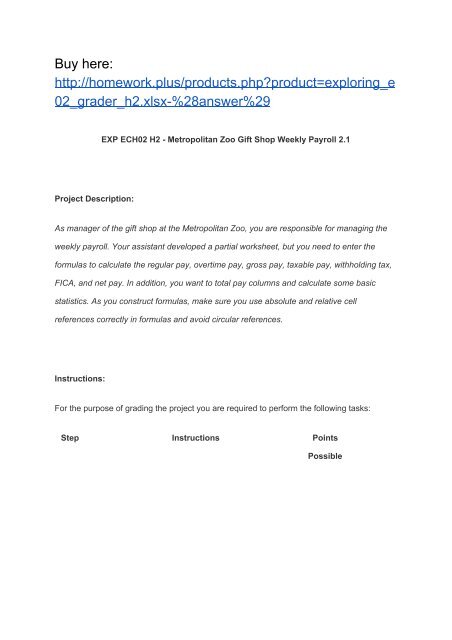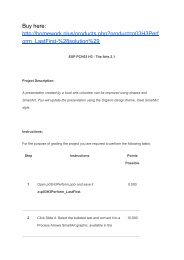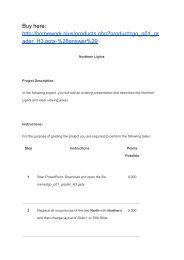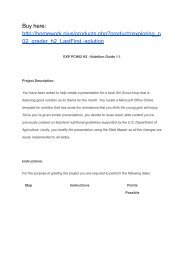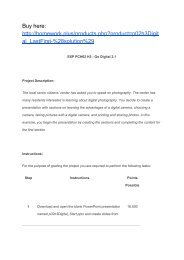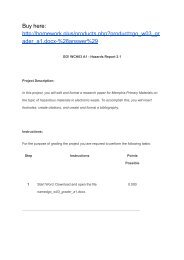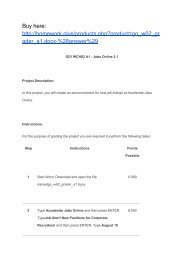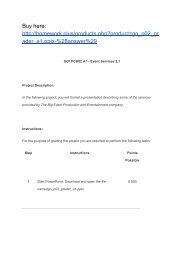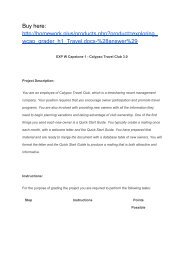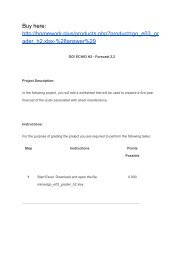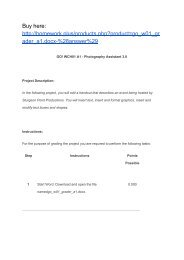exploring_e02_grader_h2.xlsxanswer
Create successful ePaper yourself
Turn your PDF publications into a flip-book with our unique Google optimized e-Paper software.
Buy here:<br />
http://homework.plus/products.php?product=<strong>exploring</strong>_e<br />
02_<strong>grader</strong>_h2.xlsx-%28answer%29<br />
EXP ECH02 H2 - Metropolitan Zoo Gift Shop Weekly Payroll 2.1<br />
Project Description:<br />
As manager of the gift shop at the Metropolitan Zoo, you are responsible for managing the<br />
weekly payroll. Your assistant developed a partial worksheet, but you need to enter the<br />
formulas to calculate the regular pay, overtime pay, gross pay, taxable pay, withholding tax,<br />
FICA, and net pay. In addition, you want to total pay columns and calculate some basic<br />
statistics. As you construct formulas, make sure you use absolute and relative cell<br />
references correctly in formulas and avoid circular references.<br />
Instructions:<br />
For the purpose of grading the project you are required to perform the following tasks:<br />
Step Instructions Points<br />
Possible
1 Start Excel. Download and open the file<br />
0.000<br />
<br />
named<strong>exploring</strong>_<strong>e02</strong>_<strong>grader</strong>_h2.xlsx. Read the<br />
business rules in the range A27:G34.<br />
2 Enter an IF function in cell E5 to calculate the regular<br />
9.000<br />
pay based on a regular 40-hour work week for the first<br />
employee. If the employee worked 40 hours or less,<br />
calculate the pay based on the hourly rate and number<br />
of actual hours worked. If an employee worked more<br />
than 40 hours, calculate the pay based on the hourly<br />
rate for only 40 hours. Use relative and absolute cell<br />
references appropriately. Do not enter the value 40 in<br />
the function. Refer to cell B21 that contains the value<br />
instead.<br />
3 Enter an IF function in cell F5 to calculate the overtime<br />
9.000<br />
pay for the first employee. If an employee worked less<br />
than 40 hours, the overtime pay is 0. If an employee<br />
worked 40 or more hours, calculate the overtime pay on<br />
only the overtime hours based on 1.5 times the hourly<br />
pay rate. Use relative and absolute cell references<br />
appropriately. Do not enter the values 40 and 1.5 in the
function. Refer to cells B21 and B22 that contain those<br />
values.<br />
4 Create a formula in cell G5 to calculate the gross pay<br />
6.000<br />
based on the regular and overtime pay for the first<br />
employee.<br />
5 Create a formula in cell H5 to calculate the taxable pay.<br />
6.000<br />
Multiply the number of dependents by the deduction per<br />
dependent (stored in cell B24), and then subtract that<br />
from the gross pay. Use relative and absolute cell<br />
references appropriately.<br />
6 Use a VLOOKUP function in cell I5 to identify and<br />
10.000<br />
calculate the federal withholding tax. The function looks<br />
up the employee’s taxable pay, compares it to the table<br />
stored in the range D21:E25, and returns the<br />
appropriate tax rate from the second column of the<br />
lookup table. Then multiply the function results by the<br />
taxable pay. Use relative and absolute cell references<br />
appropriately.
7 Calculate FICA in cell J5 based on gross pay and the<br />
6.000<br />
FICA rate (stored in cell B23). Use relative and absolute<br />
cell references appropriately.<br />
8 Calculate the net pay in cell K5 by subtracting the taxes<br />
6.000<br />
from the gross pay for the first employee.<br />
9 Copy the formulas in the range E5:K5 to the range<br />
6.000<br />
E6:K16.<br />
10 Calculate the total regular pay, overtime pay, gross pay,<br />
8.000<br />
taxable pay, withholding tax, FICA, and net pay in the<br />
respective cells within the range E17:K17.<br />
11 Apply Accounting Number Format to the ranges<br />
6.000<br />
C5:C16, E5:K5, and E17:K17.
12 Apply Comma Style to the monetary values for the<br />
4.000<br />
range E6:K16.<br />
13 Underline the last employee’s monetary values, and<br />
6.000<br />
then use the Format Cells dialog box to apply Double<br />
Accounting Underline for the totals.<br />
14 Insert appropriate functions to calculate the average,<br />
10.000<br />
highest, and lowest values in the Summary Statistics<br />
area (range I21:K23).<br />
15 You want to determine the number (frequency) of<br />
3.000<br />
employees who worked less than 20 hours, between 20<br />
and 29 hours, between 30 and 40 hours, and over 40<br />
hours. Cells J28:J31 list the ranges. You need to<br />
translate this range into correct values for the Bin<br />
column in cells I28:I30 and then enter the FREQUENCY<br />
function in the range K28:K31. The functions should<br />
identify one employee who worked between 0 and 19<br />
hours and six employees who worked more than 40<br />
hours. Use Help to learn about the FREQUENCY<br />
function, download the sample practice data to learn
how to use the function, and then close the practice<br />
document.<br />
16 Create a footer with the text Exploring Series on the<br />
5.000<br />
left side, the sheet name code in the center, and the file<br />
name code on the right side.<br />
17 Save the workbook. Close the workbook and then exit<br />
0.000<br />
Excel. Submit the workbook as directed.<br />
Total Points 100.00<br />
0


